Abstract
The paper focuses on the evaluation of heat transfer parameters in the cooling of the engine cooler clogged with silty soil at the levels of 25%, 50%, 75%, and 100%, compared to the unclogged cooler. The influence of the percentage of clogging in the fin-and-tube cooler is evaluated based on the cooler’s inlet and outlet temperatures, the heat transfer rate on both the coolant and air sides, the average heat transfer coefficient and Nusselt number, the overall heat transfer coefficient, and the air-side fouling resistance. As the percentage of cooler clogging by silty soil increased, the values of Rfa and Ts,avg also increased, while the heat transfer from the surface to the ambient environment decreased. The unclogged cooler achieved 1.07, 1.11, 1.15, and 1.16 times higher total heat transfer coefficient values compared to the 25%, 50%, 75%, and 100% clogged coolers. At the time of 90 s, the fully clogged cooler achieved a 1.9-times decrease in the heat transfer rate on the coolant side compared to the unclogged cooler. There is an inverse correlation between the Nusselt number and air-side fouling resistance, which means that an increase in the percentage of cooler clogging by silty soil caused a decrease in heat transfer and hence an increase in thermal resistance.
1. Introduction
Engine coolers represent an important component of the car cooling circuit in order to maintain the correct performance and long-term operation of the engine by efficient heat dissipation. In order to operate efficiently, effectively, and reliably, the engine must be maintained at its optimal temperature operating conditions. The coolant circulates in the car’s cooling circuit, removing heat from the engine and then dissipating it through a set of cooler tubes and fins to the ambient environment []. The most commonly used coolants are the ethylene glycol- and propylene glycol-based fluids []. Forced air convection, generated by a fan or fan assembly on the cooler, allows more intense and faster heat dissipation from the cooler to the ambient environment. Efficient cooling allows the engine to maintain a stable temperature and performance, improving combustion efficiency and reducing the amount of unburned fuel. Engine coolers are constructed of a set of tubes on which fins are mounted in dense layers. These include arrays of circular, oval, and rectangular tubes with fins and plates with fins, while the fins can be of different shapes [].
In practice, cars and trucks, construction equipment, forestry, and agricultural equipment are exposed to external adverse environmental conditions. Associated with this is the fouling of the external heat exchange surface of the cooler by layers of dust, soil, mud, and various impurities, depending on the use of cars, machines, and equipment in their operating environment. If the heat exchange surface of the cooler (tubes and fins) is clogged with impurities, there is a significant increase in thermal resistance when transferring heat from the coolant to the ambient environment. This reduces the cooling efficiency, and the heat generated in the combustion space of the engine is not cooled at a sufficient rate, which has a negative effect on the individual engine components. The continuous increase in the performance parameters of car engines imposes higher demands on the efficiency of their cooling system. If the cooler is covered with muddy, silty, or clay soil, the performance of the cooler decreases, which in the long term negatively affects the correct operation of the engine. This is confirmed by the experimental research of the author [], where the inlet and outlet coolant temperature in the cooler increased with the percentage increase in the clogged area of the cooler. By regression analysis, the authors found that every 10% increase in the surface area of the cooler clogged with muddy soil results in a 17 °C increase in the coolant outlet temperature. When clay soil was used, the increase was 20 °C. The authors [] investigated the cooling efficiency of an automobile cooler clogged with silt and mud soil. For every 10% increase in the silt-clogged area, there was a 1.7 °C increase in the coolant outlet temperature. When the area was covered with mud soil, the coolant outlet temperature increased by 2 °C. The 80% clogging of the cooler surface caused excessive engine vibration, the idle was not stable, and after a short moment, it stopped operating. When the cooler surface was clogged to 100%, the engine shut down immediately after starting.
The results of scientific research on engine cooling systems are mainly focused on the types of coolants used and their composition (ethylene glycol, propylene glycol, nanofluids), the shape and arrangement of cooler tubes, the spacing and thickness of cooler fins, and the shape and number of fan blades. There are also a number of results published in the field of fouling of heat exchanger tubes and the influence of the fouling factor on the heat transfer on the inside or outside of the tubes. Fouling of heat transfer surfaces causes technical and economic problems in industry. A fouling layer on the external surfaces of heat exchangers can be caused, for example, by the crystallization of calcium sulfate [], condensation of tar [], ash deposition [], and flue gases [], which influence the decrease in heat transfer parameters. Also, sand dust environments cause a decrease in the thermal-hydraulic performance of compact heat exchangers []. Thermo-hydraulic performance is more sensitive to particle size than particle concentration. The effect of particle size on the heat transfer of corrugated fins is relatively larger at lower Reynolds numbers in the range of 1500 to 3000.
A further factor is the velocity of the flowing fluid, which affects the rate of fouling of the pipes, with higher velocities resulting in turbulent fluid flow, which has an impact on the flushing of impurities []. Impurities accumulate especially in the recirculation region, flow stagnation region, and reattachment and vortex separation regions. Thus, the use of oval tubes in the staggered arrangement reduces the rate of fouling by impurities []. The operating conditions of heat exchangers are also an important factor in the assessment of air-side fouling. As the face air velocity increases, the cumulative deposition fraction reduces []. By increasing the diameter of the tubes due to fouling from the outside, heat transfer by conduction and convection decreases []. In the reference [], it was found that increasing the fins’ surface always improves the performance of the heat exchanger, even when it is fouled. The decrease in the heat transfer coefficient with time due to fouling showed an exponential trend.
The aim of the presented study is to experimentally investigate the heat transfer parameters of the car cooler under varying percentages of clogging of its external heat exchange surface with silty soil. For this purpose, the experimental cooling circuit of the car engine with coolant and air temperature sensors, a coolant flow sensor, an air flow velocity sensor, and a sensor measuring the heat flow from the cooler surface to the ambient environment is used. The surface temperature of the cooler was also captured non-contact by the thermal imaging camera. The values obtained from sensors and thermal imaging are applied to the calculation of average heat transfer parameters on the coolant side and on the air side. This research is motivated by the lack of comprehensive studies on the clogging of external heat exchange surfaces in engine coolers, which poses challenges for maintaining effective cooling in modern high-power engines. Engine cooling systems are often exposed to difficult operating conditions (dust, mud, silt, and clay), and it is necessary to consider the degree of fouling impact on efficiency when designing high-performance engine coolers. Silt soil combined with water often sticks to the external surface of the engine cooler, especially if the vehicle or machine is operating in muddy and wet terrain. Wet, silty soil is very adhesive and sticks to metal materials. While driving, silty soil is thrown towards the engine, where it sticks to the front grille, engine cooler, fan, or other vehicle parts. Simultaneously, heat from the cooler can accelerate the muddy soil drying process, forming a hard layer. Externally clogged coolers are common in vehicles used for off-road driving or agricultural applications, where the combination of wet soil and contact with the ground occurs. Construction machinery, military, and rescue vehicles are also exposed to muddy and silty soil in their operations. Hence, the aim of this study is to fill the research gap in this area and to evaluate the influence of the clogging of the cooler external heat exchange surface with silty soil on the heat transfer parameters during the cooling process by experimental research.
2. Materials and Methods
2.1. Experimental Setup and Measurement Procedure
The laboratory experimental measurements were carried out using the cooling circuit of the car engine with an integrated tube-and-fin cooler (Figure 1). The coolant was heated by a 1500 W spiral heating coil (6) to achieve a coolant temperature of 80 °C at the coolant inlet, which is the optimum operating temperature for a car engine. The coolant was supplied to the cooling circuit by the expansion tank (7). By starting the electric motor with the frequency converter, the water pump (4) was started. When the temperature was below 80 °C, the coolant circulated in the short cooling circuit via the water pump (4), the engine block and cylinder head (3), and the thermostatic valve (5) into the heater (6). For the purposes of ventilation and filling the coil, a reverse pipe leads from the upper section of the heater (6) to the expansion tank (7). The pipe from the heater is connected to the water pump. When the operating temperature exceeded 80 °C, the thermostatic valve (5) gradually opened, and hot coolant entered the cooler (1). If the hot coolant cannot flow under pressure through the cooler (1), some of it flows through the reverse pipe into the expansion tank (7). The cooled coolant flowed through the cooler outlet pipe into the water pump (4) and from there into a short cooling circuit until the coolant temperature decreased below 80 °C.
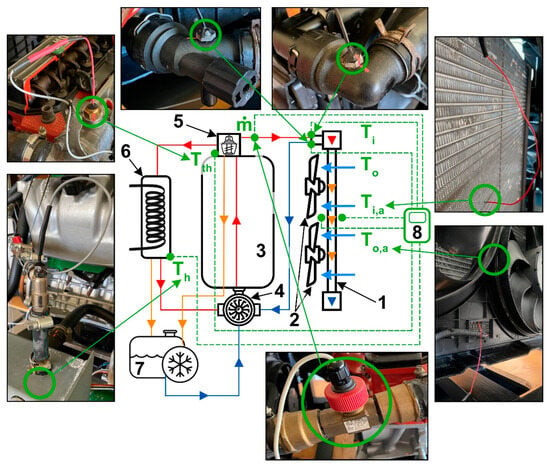
Figure 1.
Laboratory experimental setup of a car engine cooling circuit. 1—engine cooler, 2—cooler fan, 3—car engine, 4—water pump, 5—thermostat, 6—heater, 7—expansion tank, 8—data logger, ṁ—coolant mass flow rate sensor, Ti—temperature sensor in the cooler inlet pipe (coolant inlet temperature), To—temperature sensor in the cooler outlet pipe (coolant outlet temperature), Ti,a—temperature sensor located in front of the cooler (inlet air temperature), To,a—temperature sensor located behind the cooler (outlet air temperature), Th—temperature sensor located in the heater, Tth—temperature sensor located in the thermostat.
The temperature of the coolant at the inlet and outlet of the cooler, Ti and To, was recorded during the cooling process using NTC-type thermistors ZA 9040-FS with an accuracy of ±0.01 °C (Figure 1). The air temperature in front of and behind the cooler Ti,a and To,a, the temperature in the heater Th, and the temperature in the thermostat Tth were measured using NTC ZA 9040-FS thermistors (Murata Manufacturing, Kyoto, Japan) with an accuracy of ±0.01 °C. The coolant mass flow rate was measured using the FVA 915VTH flow meter (Ahlborn Mess-und Regelungstechnik GmbH, Holzkirchen, Germany) with an accuracy of ±1%. The surface temperature of the cooler was measured using a NiCr-Ni Thermo ZA 9020-FS thermocouple (Ahlborn Mess-und Regelungstechnik GmbH, Holzkirchen, Germany) with an accuracy of ±0.05% of the measured value and using a Flir T865 thermal imaging camera (Flir, W-Technika group s.r.o., Žilina, Slovakia) with an accuracy of ±1 °C for temperatures ranging from 0 to 100 °C. The sensors were connected to the data logger ALMEMO 2590-4S (8) (Ahlborn Mess-und Regelungstechnik GmbH, Holzkirchen, Germany). The forced air was generated by an axial pressure industrial fan, Master DF20P (Master, Shanghai, China) (diameter 500 mm, 3 speeds with 98/100/107 W power consumption, 230 V/50 Hz power supply). To ensure stable output power of the industrial fan, the industrial switching power supply is equipped with a MOSFET power transistor (SMIC, Shanghai, China), which ensures a fast response to load changes. The measurement of the forced air velocity and the air velocity generated by the fan on the cooler was performed during the cooling process in a 3 × 3 grid in front of the cooler by means of a digital vane anemometer FVAD15-H140 (Ahlborn Mess-und Regelungstechnik GmbH, Holzkirchen, Germany) with an accuracy of ±1% of the measured value and a maximum resolution of 0.01 m/s.
The cooler was cooled from the outside with air using a system of two fans with a power of 250 W and 150 W for blades of diameter ϕ345 mm and ϕ290 mm, respectively (Figure 2(2)). The two fans were activated at the same time to cool the coolant circulating through the cooler. The cooler consists of 44 tubes in the inline arrangement (22 tubes in each row), with an outer diameter of ϕ6 mm and a spacing between tubes of 18 mm (Figure 2(1a)). The spacing between the first and second rows of tubes is 10 mm. The basic dimensions of the cooler’s heat exchange surface are 630 mm in length, 415 mm in height, and 24 mm in width (Figure 2(1,1b)). The cooler tubes are fitted with fins of thickness 0.25 mm and spacing between fins of 1 mm. The material of cooler tubes and fins is made of AW-3003 aluminum alloy with a thermal conductivity coefficient of 190 W/(m·K). The coolant flows through the tube-and-fin cooler transversely in two passes so that the cooler is divided into two parts in the horizontal plane. ZA 9040-FS NTC thermistors are installed in the inlet and outlet pipes of the cooler (Figure 2(3)).
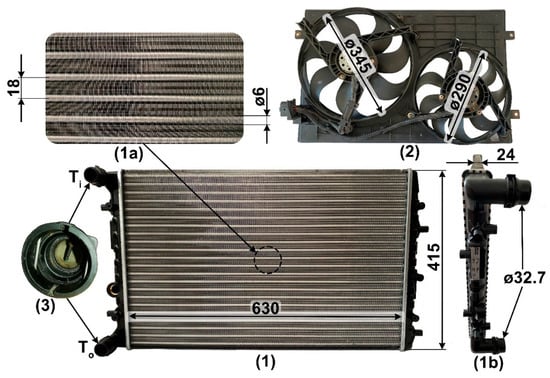
Figure 2.
Experimentally investigated a fin-and-tube cooler with a pair of fans. (1) Basic dimensions of the cooler in mm, (1a) outer diameter of the tubes and spacing between the tubes, (1b) width of the cooler and diameter of the inlet and outlet pipes, (2) fan blade diameters, and (3) fitting of the coolant temperature sensors at the inlet and outlet pipes of the cooler.
The coolant used in the study was a G12+ water–ethylene glycol mixture prepared in a 50:50 volume ratio, ensuring frost resistance to −35 °C. The physical properties of the ethylene glycol used at the temperature of 80 °C are as follows: thermal conductivity 0.46573 W/(m·K), specific heat 3.4225 × 103 J/(kg·K), density 1.0232 × 103 kg/m3, kinematic viscosity 8.4281 × 10−7 m2/s, dynamic viscosity 8.6236 × 10−4 kg/(m·s), thermal expansion coefficient 2.8317 × 10−3 K−1, and thermal diffusivity 1.3299 × 10−7 m2/s. The total heat exchange area of the tubes and fins is 8.8 m2. The thermal conductivity of tubes of AlMn1Cu, aluminum alloy AW-3003, is 190 W/(m·K).
A layer of silty soil mixed with water, 2 mm thick, was applied to the front external heat exchange surface of the cooler, gradually covering 25%, 50%, 75%, and 100% of the surface (Figure 3). Proportional dimensions were calculated for individual percentage clogging of the cooler based on the width and height dimensions of the clean cooler, 0.635 m and 0.420 m, respectively. The cooler was clogged from the central axis towards the sides.

Figure 3.
The percentage of the external heat exchange surface of the cooler covered with silty soil. (a) 0%, (b) 25%, (c) 50%, (d) 75%, (e) 100%.
The heat transfer rate uncertainty was obtained by the standard uncertainty propagation method [,]. The relative uncertainties of the calculated heat transfer parameters are summarized in Table 1.

Table 1.
The accuracy of physical quantity sensors and the relative uncertainties of the heat transfer parameters.
2.2. Data Reduction
Heat transfer rate on the coolant side []:
where —mass flow rate of coolant kg/s; cp—specific heat capacity of coolant at constant pressure, J/(kg·K); Ti—coolant inlet temperature, K; To—coolant outlet temperature, K.
Heat transfer rate on the air side []:
where —mass flow rate of air; kg/s, cp,a—specific heat capacity of air at constant pressure, J/(kg·K); Ti,a—air inlet temperature, K; To,a—air outlet temperature, K.
Average heat transfer coefficient on the air side []:
where —total heat exchange surface of tubes and fins, m2; Ts,avg—average surface temperature obtained from thermal images, K; —bulk temperature, K.
Average Nusselt number []:
where —outer diameter of tube (m); ka—thermal conductivity of air, W/(m·K).
Overall heat transfer coefficient []:
where —heat transfer coefficient on the coolant side, W/(m2·K); δ—tube wall thickness, m; ks—thermal conductivity of tube material, W/(m·K); —heat transfer coefficient on the air side, W/(m2·K).
Air-side fouling resistance []:
where Ur—real overall heat transfer coefficient, W/(m2·K); Uc—overall heat transfer coefficient of the clear/unfouling cooler, W/(m2·K).
3. Results and Discussion
3.1. Evaluation of the Cooling Process on the Coolant Side When Varying the Fouling of the External Heat Exchange Surface of the Cooler
The temperatures of the coolant at the inlet and outlet of the cooler when varying the percentage of fouling of the cooler’s external surface during the cooling process are shown in Figure 4. The cooling by two fans always started when the inlet temperature of the cooler reached approximately 80 °C, and the cooling was finished when the outlet temperature of the cooler reached 30 °C. As the percentage of cooler clogging increased, the cooling time also increased from 7 min for 0% cooler clogging to 12 min for 100% cooler clogging. The larger the external surface area of the cooler covered with silty soil, the lower the heat dissipation from the cooler to the surroundings, and thus the cooling time increases.
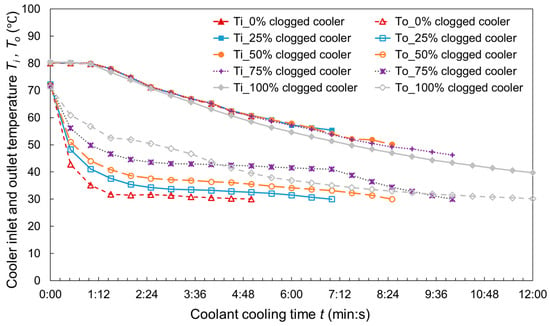
Figure 4.
Influence of the percentage of clogging of the cooler’s external surface area on the inlet and outlet coolant temperatures.
The values ΔTi and ΔTo presented in Table 2 represent the temperature difference between Ti at the start of cooling and at the end of cooling, and To at the start of cooling and at the end of cooling. Δt represents the time difference between the start and end of the cooling process. Table 2 indicates a gradual increase in ΔTi with the percentage of the external surface area of the cooler covered with silty soil, from 19.50 °C for the unclogged cooler to 40.67 °C for the 100% clogged cooler. The variations in the outlet temperature ΔTo were not so pronounced and, on the contrary, were decreasing in character (from 42.41 °C to 41.13 °C). When comparing the unclogged and completely clogged coolers, it can be concluded that the temperature change at the cooler inlet increased up to 2.09 times due to insufficient heat dissipation from the cooler to the ambient environment. Table 2 shows that as the percentage of the external surface area of the cooler increases, the cooling time increases. At the same time, the temperature difference at the inlet to the cooler increases significantly, and the temperature difference at the outlet of the cooler indicates a moderate decrease with increasing clogging. At a higher percentage of clogging, the coolant is overheated before entering the cooler, which is indicated by a higher temperature difference ΔTi. At the same time, the temperature difference at the cooler outlet decreases, which is related to a decrease in the thermal efficiency of the cooler and confirms the negative effect of cooler clogging on the overall cooling process.

Table 2.
Temperature differences at the inlet and outlet of the cooler between the start and the end of cooling when the percentage of the external heat exchange surface of the cooler clogged with silty soil is varied.
The influence of silt, mud, and clay soil on the inlet and outlet temperatures of a car engine cooler has been studied and published in the references [,]. These types of soil enter the engine compartment of the car and consequently the surface of the engine cooler when driving on unpaved roads, in the rain, or in muddy terrain. In addition, the cooler fan and the vehicle’s motion itself cause small particles of soil to be sucked toward the engine cooler. Silt and clay soils can quickly stick to the surface of the cooler and clog its fins, forming a solid layer when dry that impedes airflow, reducing cooling performance and causing the overheating of the engine.
The authors’ findings [] indicate that the percentage area covered by silt and clay resulted in a proportional increase in the inlet and outlet temperatures of the coolant in the cooler (Figure 5a,b). The mathematical model developed by [] also predicted the experimental data very well. The coverage of the external surface of the cooler was realized from 0% to 100% with an increase of 10%. The temperature difference at the cooler outlet for the unclogged and fully clogged coolers reached values of 15 °C and 21 °C for silt soil and clay soil, respectively. In the presented study, the temperature difference at the cooler outlet for silty soil reaches a value of 20.81 °C. (Figure 5b). In the literature [], the external surface of the cooler was covered with muddy soil from 20% to 100% in 10% increments. The temperature difference at the cooler outlet for a 20% clogged cooler and 100% clogged cooler reached values of 20 °C and 13 °C for silt soil and mud soil, respectively (Figure 5b). In the presented study, the coolant temperature at the cooler outlet is 3.56 °C higher than the average outlet coolant temperatures of the compared authors. The discrepancies are caused mainly by the type and thickness of fouling, the dimensions of the coolers examined, and the number of tubes and fins in the coolers.
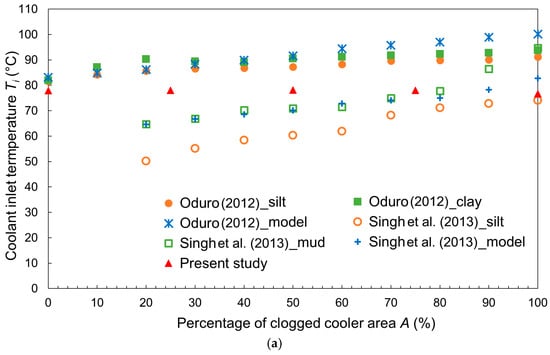
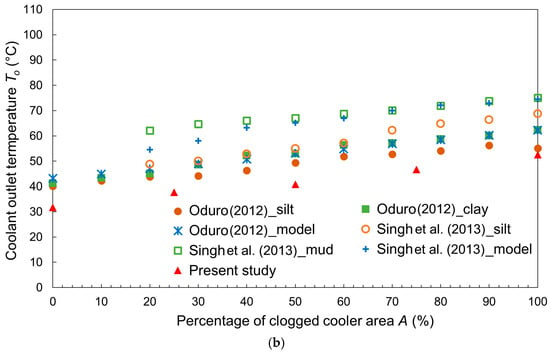
Figure 5.
Comparison of the present study to the authors’ study of the effect of silt, clay, and mud on the inlet and outlet temperatures of the coolant. (a) variation in coolant inlet temperature with percentage clogging of the external cooler area [,], (b) variation in coolant outlet temperature with percentage clogging of the external cooler area [,].
The influence of the percentage clogging of the cooler’s external heat exchange surface is also evident from the heat transfer rate values on the coolant side, Qc (Figure 6). The Qc values were calculated according to Equation (1). In all combinations examined, the maximum heat transfer rate was achieved when the coolant was cooled for 1 min and 30 s. Until this time, the Qc values increased, and from 1:30, they decreased gradually until the cooler outlet temperature reached 30 °C. The unclogged cooler reached a maximum heat transfer rate of 113.69 kW, while the 100% clogged cooler reached only 59.52 kW at the same time. This means that the Qc value of the fully clogged cooler has decreased by 1.9 times.
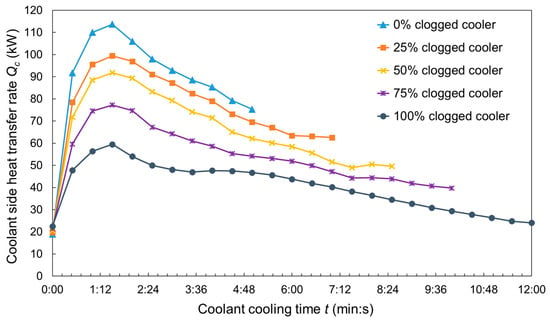
Figure 6.
Heat transfer rate waveforms on the coolant side during the cooling process when varying the percentage of clogging of the cooler’s external surface.
3.2. Subsection Evaluation of the Cooling Process on the Air Side When Varying the Fouling of the External Heat Exchange Surface of the Cooler
The surface temperatures of the cooler’s external heat exchange surface under cooling conditions with a percentage change in fouling were also recorded by a thermal imaging camera (Figure 7). The average surface temperature for all thermal images was evaluated using Flir Thermal Studio software, version 2.0 (W-Technika group s.r.o., Žilina, Slovakia). From the Ts,avg waveforms, it is evident that the lowest surface temperatures during the cooling process were reached by the 0% clogged cooler. With the gradual percentage clogging of the heat exchange surface with silty soil, there was an increase in the average surface temperature. At the same time, the average surface temperatures decrease with the cooling time. The cooling time gradually increases with the percentage of clogging of the cooler’s external surface.
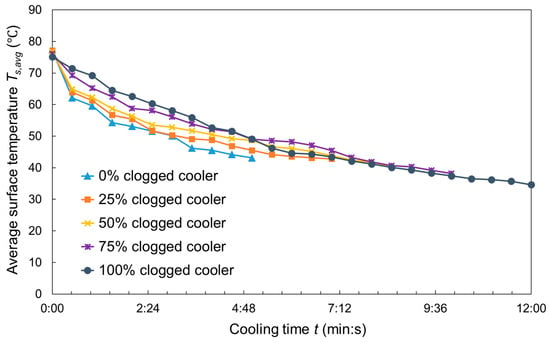
Figure 7.
Average surface temperature waveforms on the cooler’s external surface during the cooling process when varying the percentage of the cooler’s external surface clogging.
The higher surface temperatures subsequently also affected the heat transfer rate on the air side, Qa (Figure 8). The Qa values were calculated according to Equation (2). The maximum values of Qa were achieved at the start of cooling in the range of 62.83 kW to 60.27 kW for the unclogged to gradually completely clogged cooler. With the increase in cooling time, the heat transfer rate on the air side decreased to values ranging from 24.68 kW to 14.85 kW for the unclogged to gradually completely clogged cooler. It can be concluded that the Qa value of the fully clogged cooler decreased by 1.0 to 1.7 times from the start to the end of cooling compared to the unclogged cooler.
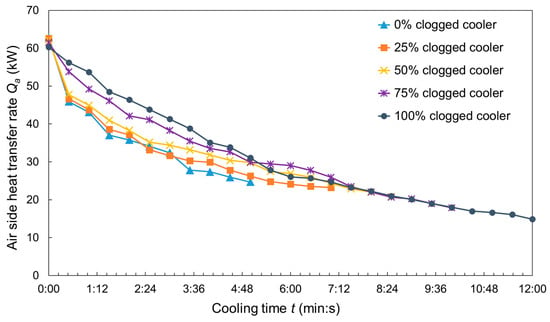
Figure 8.
Heat transfer rate waveforms on the air side during the cooling process when varying the percentage of clogging of the cooler’s external surface.
The variation in the average heat transfer coefficient, havg, calculated from Equation (3), with the cooling time is shown in Figure 9. The unclogged cooler achieved the highest havg values in the range of 135.3 W/(m2·K) to 153.5 W/(m2·K). With gradual percentage clogging of the cooler’s external heat exchange surface, the havg values decreased from 125.5 W/(m2·K) to 123.0 W/(m2·K) in the case of a 100% clogged cooler. It can be concluded that even at the start of the cooling process, the unclogged cooler achieved an average heat transfer coefficient 1.1 times higher than the completely clogged cooler. When the cooler is clear, the average heat transfer coefficient from its surface to the surroundings increases with cooling time because there is nothing to resist heat transfer to the ambient environment. On the contrary, the impurities on the external surface of the cooler gradually cause a lower increase in havg with cooling time, as can be seen with 25% and 50% cooler clogging. Moreover, when the cooler is clogged at 75% and 100%, the havg waveform only decreases.
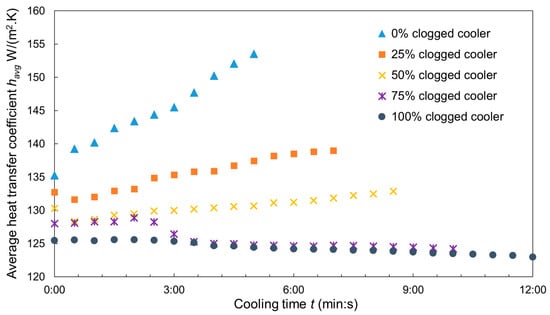
Figure 9.
Variation in the average heat transfer coefficient on the air side during the cooling process when varying the percentage of clogging of the cooler’s external surface.
Based on the average heat transfer coefficient values, the average Nusselt number values (Figure 10) were calculated according to Equation (4). The increase and decrease in Nuavg values are shown in Table 3, and the increase in Nuavg with cooling time was achieved only for 0%, 25%, and 50% cooler clogging. On the contrary, 75% and 100% cooler clogging showed a decrease in Nuavg during the cooling process. It indicates that the higher percentage of silt clogging the cooler causes a decrease in heat dissipation from the cooler to the surroundings, even with two cooling fans on the cooler. This can lead to damage to engine components during long-term operation of the vehicle.
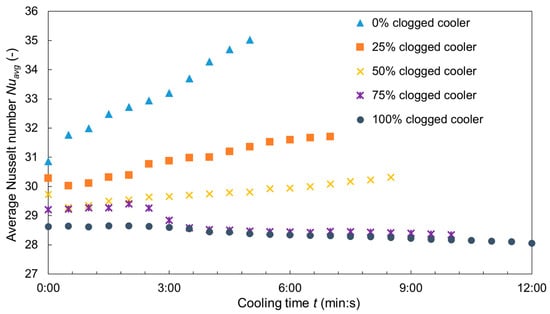
Figure 10.
Variation in the average Nusselt number on the air side during the cooling process when varying the percentage of clogging of the cooler’s external surface.

Table 3.
Increase and decrease in the average Nusselt number when varying the percentage of clogging of the external cooler’s heat exchange surface at the cooling time.
The overall heat transfer coefficients U calculated according to Equation (5) are shown in Figure 11. These values combine heat transfer by convection from the coolant to the tube wall, heat transfer by conduction through the tube wall, and heat transfer by convection from the tube surface to the surrounding air. The value waveforms correspond to the havg and Nuavg waveforms. As predicted, the unclogged cooler achieved the highest overall heat transfer coefficient in the range of 134.93 W/(m2·K) to 153.08 W/(m2·K) during the cooling process. When comparing the unclogged cooler and the fully clogged cooler by averaging the overall heat transfer coefficient values, the unclogged cooler achieved a 1.16 times higher U value. When comparing the unclogged cooler and the 25%, 50%, and 75% clogged coolers, the unclogged cooler achieved 1.07, 1.11, and 1.15 times higher U values. The cooling time increases with the percentage increase in clogging of the cooler’s external surface, gradually from 5 to 12 min.
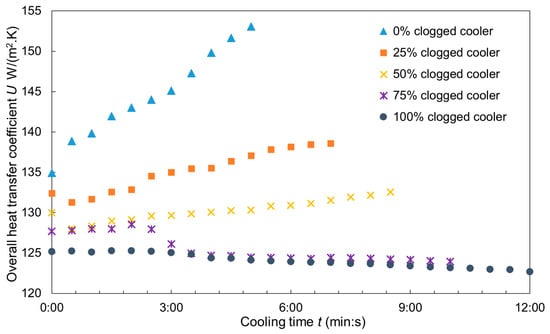
Figure 11.
The variation in the overall heat transfer coefficient with the percentage of fouling of the cooler’s external heat exchange surface.
The fouling resistance on the air side Rfa values during the cooling process, calculated from Equation (6), are shown in Figure 12. For the comparison of values in the same cooling time range, the Rfa values are presented for the first 5 min of cooling. As the percentage of the cooler’s external heat exchange surface fouled by silty soil increased, the Rfa values also increased. The highest Rfa values in the range of 0.58 × 10−3 to 1.52 × 10−3 (m2·K)/W were achieved by the 100% clogged cooler versus the 0% clogged cooler. The cooler clogged at 25%, 50%, and 75%, acquiring values in the range of 0.14 × 10−3 to 0.76 (m2·K)/W, 0.28 × 10−3 to 1.14 (m2·K)/W, and 0.42 × 10−3 to 1.50 (m2·K)/W, respectively. Simultaneously, with an increase in cooling time, the Rfa values increased during five minutes of cooling. The higher percentage difference between the clogged and unclogged cooler surface leads to higher fouling resistance on the air side. The calculated Rfa values are in agreement with values commonly achieved in dusty and off-road conditions while driving a car.
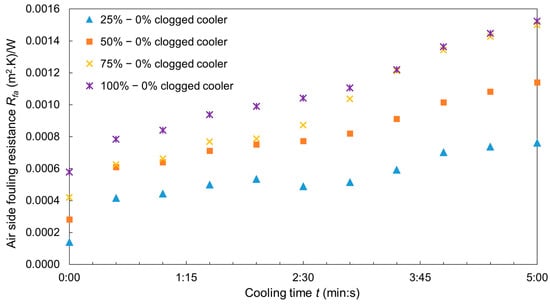
Figure 12.
Variation in fouling resistance on the air side during five minutes of the cooling process when varying the percentage difference between the clogged and unclogged external surface of the cooler.
Figure 13 shows the influence of air-side fouling resistance on Nusselt numbers when varying the percentage difference between the clogged and unclogged external surface area of the cooler. The value of Nu decreases with an increase in Rfa, because the surface covered with a layer of silty soil acts as an insulation layer that reduces air flow and heat dissipation. The unclogged cooler achieved the highest Nu values in the range of 30.86 to 35.02 during the cooling interval of 5 min. The fully clogged cooler reached Nu values ranging from 28.06 to 28.65 during the cooling interval of 12 min, which corresponds to Rfa values ranging from 0.578 × 10−3 to 1.52 × 10−3 (m2·K)/W. As the percentage of clogging of the cooler’s external heat exchange surface increased, the Rfa values increased and the Nu values decreased.
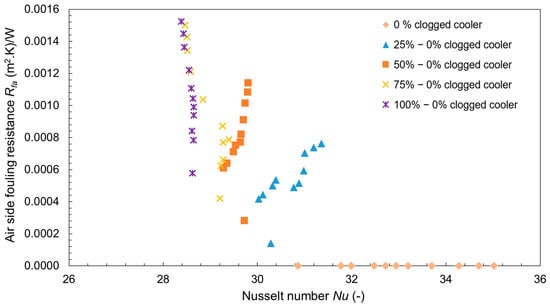
Figure 13.
The influence of fouling resistance on the air side on the Nusselt numbers when varying the percentage difference between the clogged and unclogged external surface of the cooler.
The reduced cooling efficiency of the engine leads to a risk of engine overheating, which can cause permanent damage, cracking of the cylinder head gasket, deformation of the cylinder head, or engine stalling. When the engine temperature is high, the engine cooler fans are activated more frequently, which increases energy consumption and leads to higher fuel consumption. Similarly, operating the engine at a higher than optimal operating temperature can affect the combustion process, reducing engine power, and the driver feels this as a loss of acceleration.
4. Conclusions
The insufficient heat dissipation from the cooler surface to the surroundings reduces the reliability and service life of the engine and increases operating costs. Especially, vehicles operated in dusty environments require periodic inspection and cleaning of engine coolers. The drying of the muddy and silty soil on the external surface of the engine cooler causes the creation of an insulating layer that inhibits the effective transfer of heat from the surface of the cooler tubes and fins to the surroundings and also inhibits the effective airflow from the fans installed on the engine cooler. The results of the experimental research indicate several partial conclusions:
- -
- The difference in the coolant inlet temperatures at the start and the end of cooling, ΔTi, increased up to 2.09 times when comparing the unclogged and fully clogged coolers. The increase in ΔTi is a response to the reduced heat dissipation from the cooler due to the gradual clogging of its external heat exchange surface with silty soil.
- -
- The unclogged cooler reached its maximum heat transfer rate on the coolant side at the time of 1:30 (Qc = 113.69 kW). At the same time, the fully clogged cooler achieved Qc = 59.52 kW, which means a 1.9-times decrease in the Qc value of the fully clogged cooler.
- -
- The average heat transfer coefficient havg of the unclogged cooler reached, even at the beginning of the cooling process, 1.1 times higher values compared to the 100% clogged cooler. When the cooler is clear of fouling, havg values increase with the cooling time because there is no obstacle to heat dissipation into the surroundings. On the contrary, fouling on the external surface of the cooler causes a slight increase in havg with cooling time, as can be seen with 25% and 50% cooler fouling. Even when the cooler is clogged at 75% and 100%, the havg values only decrease.
- -
- The increase in Nuavg values of 1.13, 1.05, and 1.02 times with the cooling time was achieved only for 0%, 25%, and 50% cooler clogging. In contrast, 75% and 100% cooler clogging showed a decrease in Nuavg of 0.97 and 0.98 times during the cooling process. That is, a higher percentage of cooler clogging with silty soil results in a decrease in heat dissipation from the cooler to the surroundings, even in the case of cooling with a fan mounted on the cooler.
- -
- The unclogged cooler achieved a 1.16 times higher overall heat transfer coefficient U compared to the 100% clogged cooler. When comparing the unclogged cooler and coolers clogged by 25%, 50%, and 75%, the unclogged cooler achieved U values of 1.07, 1.11, and 1.15 times higher.
- -
- The percentage of clogging of the cooler’s external heat exchange surface with silty soil, the Rfa values increased. Simultaneously, with the increase in cooling time, the Rfa values increased during the five minutes of the cooling process.
- -
- There is an inverse correlation between the Nusselt number and the air-side fouling resistance, i.e., the increase in the percentage of cooler fouling by silty soil caused a decrease in heat transfer and thus an increase in thermal resistance.
Author Contributions
Conceptualization, Z.B.; validation, Z.B.; formal analysis, Z.B. and M.L.; investigation, M.L.; resources, Z.B.; data curation, Z.B.; writing—original draft preparation, Z.B.; writing—review and editing, Z.B. and M.L.; supervision, Z.B.; project administration, M.L. All authors have read and agreed to the published version of the manuscript.
Funding
This research was funded by the grant project “Progressive Research into Utility Properties of Materials and Products Based on Wood (LignoPro)”, ITMS 313011T720, supported by the Operational Program Integrated Infrastructure (OPII), funded by the ERDF, and by the EU NextGenerationEU through the Recovery and Resilience Plan for Slovakia under project No. 09I03-03-V05-00016, IPA 1/2024, Investigation of Innovative Approaches to Cooling the External Heat Exchange Surfaces of Automotive Coolers.
Institutional Review Board Statement
Not applicable.
Informed Consent Statement
Not applicable.
Data Availability Statement
The raw data supporting the conclusions of this article will be made available by the authors on request.
Conflicts of Interest
The authors declare no conflicts of interest.
Abbreviations
The following abbreviations are used in this manuscript:
| A | percentage clogged cooler area (%) |
| At | total heat exchange surface of tubes and fins (m2) |
| cp | specific heat capacity at constant pressure (J/(kg·K)) |
| D | outer diameter of tube (m) |
| Δ | difference in values |
| δ | tube wall thickness (m) |
| h | heat transfer coefficient (W/(m2·K)) |
| k | thermal conductivity (W/(m·K)) |
| ṁ | mass flow rate (kg/s) |
| NTC | Negative Temperature Coefficient |
| Q | heat transfer rate (W) |
| Rf | fouling resistance ((m2·K)/W) |
| T | temperature (K) |
| Tb | bulk temperature (K) |
| t | time (min:s) |
| U | overall heat transfer coefficient (W/(m2·K)) |
| a | air |
| Subscripts | |
| avg | average |
| c | coolant |
| h | heater |
| i | inlet |
| o | outlet |
| s | surface |
| th | thermostat |
References
- Patil, V.R.; Patil, S.S.; Kumbhar, V.; Kolhe, K. Review of Problems of Heat Transfer in Car Radiator and Suggested Solutions. IJSDR 2017, 2, 94–98. [Google Scholar]
- Gollin, M.; Bjork, D. Comparative Performance of Ethylene Glycol/Water and Propylene Glycol/Water Coolants in Automobile Radiators. SAE Tech. Pap. 1996, 115–123. [Google Scholar] [CrossRef]
- Arunpandiyan, D. A Review of Automotive Radiator Performance. IJIRST 2016, 2, 166–169. [Google Scholar]
- Oduro, S.D. Assessing the Effect of Blockage of Dirt on Engine Radiator in the Engine Cooling System. Int. J. Automot. Eng. 2012, 2, 163–171. [Google Scholar]
- Singh, Y.; Singh, N.K. Dirt Analysis on the Performance of an Engine Cooling System. J. Energy South. Afr. 2013, 24, 44–50. [Google Scholar] [CrossRef]
- Brahim, F.; Augustin, W.; Bohnet, M. Numerical Simulation of the Fouling Process. Int. J. Therm. Sci. 2003, 42, 323–334. [Google Scholar] [CrossRef]
- Aldi, N.; Casari, N.; Pinelli, M.; Suman, A.; Vulpio, A. Performance Degradation of a Shell-and-tube Heat Exchanger due to Tar Deposition. Energies 2022, 15, 1490. [Google Scholar] [CrossRef]
- Fu, L.; Liu, P.; Li, G. Numerical Investigation on Ash Fouling Characteristics of Flue Gas Heat Exchanger. Appl. Therm. Eng. 2017, 123, 891–900. [Google Scholar] [CrossRef]
- Shi, Y.-T.; Gao, M.; Tang, G.-H.; Sun, F.-Z.; Tao, W.-Q. Experimental Research of CFB Ash Deposition on Helical Finned Tubes. Appl. Therm. Eng. 2012, 37, 420–429. [Google Scholar] [CrossRef]
- Miao, L.; Wang, Y.; Kavtaradze, R.; Guo, F.; Li, Y. Investigation of the Heat Transfer and Flow Characteristics in Wavy Fins of Compact Heat Exchanger in a Sand-Dust Environment. Int. J. Heat Mass Transf. 2021, 168, 120879. [Google Scholar] [CrossRef]
- Al-Hadhrami, L.M.; Ahmad, A.; Al-Qahtani, A. Experimental Study of Fouling Resistance in Twisted Tube Heat Exchanger. Heat Transf. Eng. 2012, 33, 1024–1032. [Google Scholar] [CrossRef]
- Han, H.; He, Y.L.; Tao, W.-Q.; Li, Y.-S. A Parameter Study of Tube Bundle Heat Exchangers for Fouling Rate Reduction. Int. J. Heat Mass Transf. 2014, 72, 210–221. [Google Scholar] [CrossRef]
- Inamdar, H.V.; Groll, E.A.; Weibel, J.A.; Garimella, S.V. Air-side Fouling of Finned Heat Exchangers: Part 2, Experimental Investigation and Assessment of Test Protocol. Int. J. Refrig. 2023, 151, 63–76. [Google Scholar] [CrossRef]
- Kaptan, Y.; Buyruk, E.; Ecder, A. Numerical Investigation of Fouling on Cross-flow Heat Exchanger Tubes with Conjugated Heat Transfer Approach. Int. Commun. Heat Mass Transf. 2008, 35, 1153–1158. [Google Scholar] [CrossRef]
- Edelin, D.; Bariteau, N.; Etourneau, Y.; Traonvouez, L.; Soto, J. Experimental Investigation of the Air Side Fouling of Finned Tube Heat Exchagners. Heat Mass Transf. 2019, 55, 2713–2722. [Google Scholar] [CrossRef]
- Moffat, R.J. Describing the Uncertainties in Experimental Results. Exp. Therm. Fluid Sci. 1988, 1, 3–17. [Google Scholar] [CrossRef]
- Park, Y.-G. Correcting Energy Balance Error in Heat Exchanger Data by Maximum Likelihood Method. Appl. Therm. Eng. 2018, 131, 311–319. [Google Scholar] [CrossRef]
- Tuncer, A.D.; Sözen, A.; Khanlari, A.; Gürbüz, E.Y.; Variyenli, H.I. Analysis of Thermal Performance of an Improved Shell and Helically Coiled Heat Exchanger. Appl. Therm. Eng. 2021, 184, 116272. [Google Scholar] [CrossRef]
- Taler, J.; Ocloń, P.; Taler, D.; Nowak-Ocloń, M. Computer-aided Determination of the Air-side Heat Transfer Coefficient and Thermal Contact Resistance for a Fin-and-tube Heat Exchanger. In Heat Transfer Studies and Applications; Kazi, S.N., Ed.; InTech: London, UK, 2015; pp. 260–292. [Google Scholar]
- Park, J.M.; Kim, O.J.; Kim, S.J.; Shin, Y.-C. Heat Transfer Characteristics of Circular and Elliptic Cylinders in Cross Flow. Adv. Mech. Eng. 2015, 7, 1687814015619553. [Google Scholar] [CrossRef]
- Mostafa, M. Fouling of Heat Transfer Surface. In Heat Transfer—Theoretical Analysis, Experimental Investigations and Industrial Systems; Belmiloudi, A., Ed.; InTech: London, UK, 2011; pp. 505–542. [Google Scholar]
Disclaimer/Publisher’s Note: The statements, opinions and data contained in all publications are solely those of the individual author(s) and contributor(s) and not of MDPI and/or the editor(s). MDPI and/or the editor(s) disclaim responsibility for any injury to people or property resulting from any ideas, methods, instructions or products referred to in the content. |
© 2025 by the authors. Licensee MDPI, Basel, Switzerland. This article is an open access article distributed under the terms and conditions of the Creative Commons Attribution (CC BY) license (https://creativecommons.org/licenses/by/4.0/).